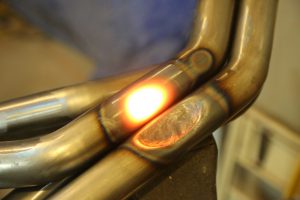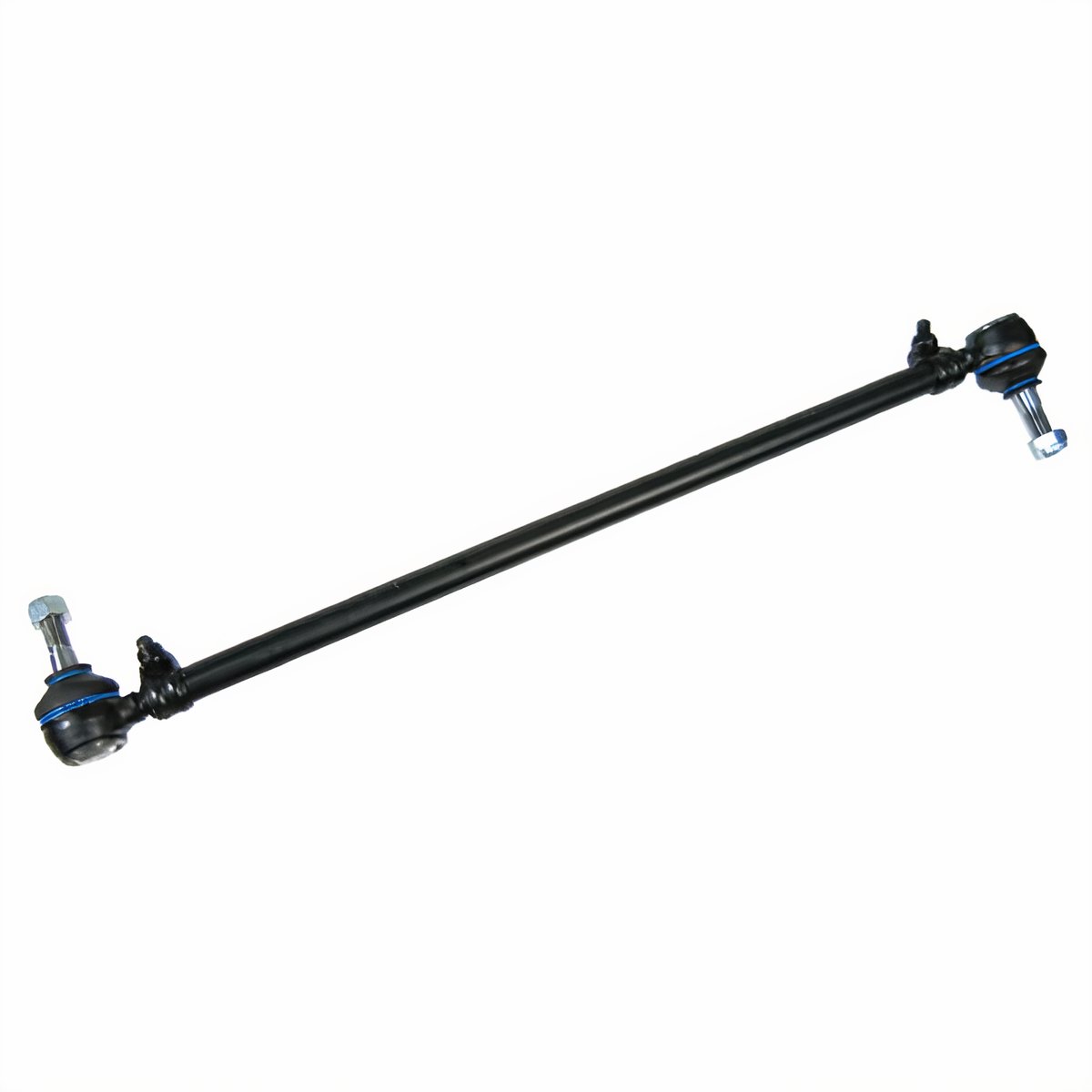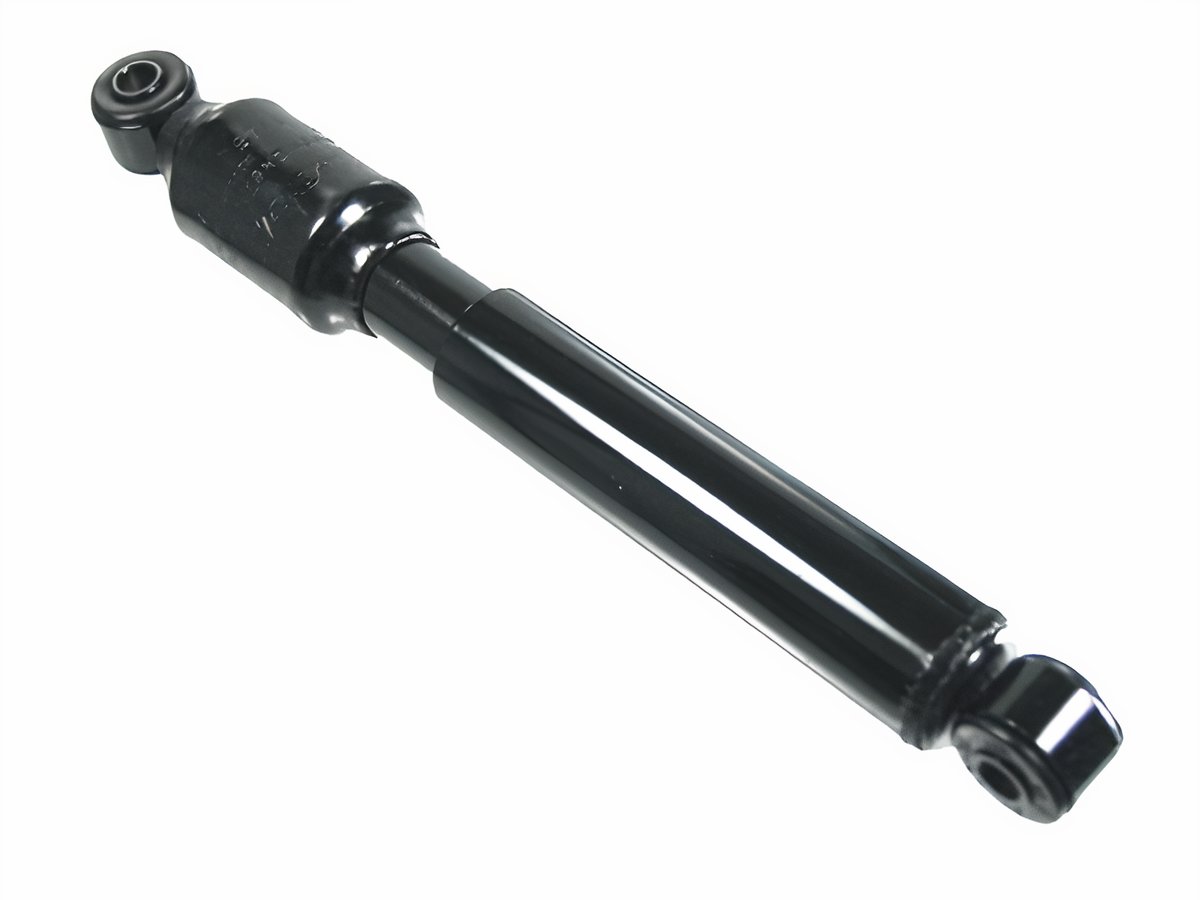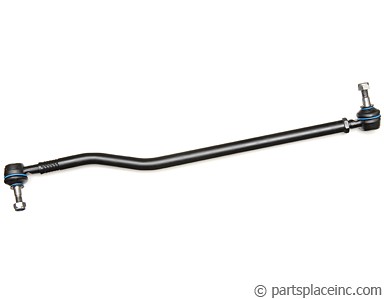Caster, Camber and Toe
On modern cars, a front end alignment involves tweaking three different adjustments. Caster is the rotational pitch the front wheel revolves on. This is hard to put into words, but picture the front wheel on a shopping cart and how it wobbles when you get a "bad" one. Your front wheel can have the same effect, caused by the castor being off. Camber is what the tuners and drifters use for either visual effect or performance. Camber speaks to how much the top of the tires tilt away from or towards the car. Toe references how much the front or rear of the tire is closer to the center line of the car. Of the three, only Toe is adjustable on an MGB.
Frozen Nut
Like so many parts on the old bus, when I got under the MGB to loosen the lock nut on the tie rods, both nuts were frozen in-place. I applied heavy amounts of WD40 Rust Release Penetrant to break them free, but they remained stuck after soaking overnight. I continued to spray that stuff for a total of 4 days (2 applications a-day). They wouldn't budge. Grrr.. fun with rust. So, I thought this would be a great opportunity to compare various penetrating oils. I dug around my garage and found that I had Tool Box Buddy (by Lucas Oil) and the classic PB Blaster in addition to the WD40 penetrant. Experiment time!
I switched to the Tool Box Buddy. From the start, the Tool Box Buddy acted differently. The WD40 spray would land on the tie-rod threads, but mostly just drip off onto the ground. I had to spray quite a bit on there to feel like it was getting under the nut at all. In contrast, I could watch the Tool Box Buddy wick under the nut when I sprayed it on, and far less dripped onto the ground. Once I saw that, I figured the WD40 product just wasn't as well made for the task. I wanted the experiment to be fair, though so for as close a comparison as I could make, I followed the same pattern of spraying some on twice a day: morning and night. I realize that it is possible that there could have been some residual benefit from the WD40, but considering how immobile the nuts were before switching, I don't think there was much. After 4 applications of the Tool Box Buddy, I tried to move the nuts. They still wouldn't budge, or more accurately, no matter how firm a grip I put on the tie-rod, it would still move in the grips when I put pressure on the nut. So I went a different way.
 I hit the neighborhood Ace Hardware and got 2 9/16" fine-thread nuts ($0.85US each). I completely loosened the clamp holding the rubber boots and then lifted the front wheels off the ground. I then turned the tie-rod until it separated from the tie-rod end, and threaded the 2 new nuts on the end. I snugged the 2 nuts together, locking the outer nut from moving inward. I put a 7/8" socket on the outer nut, clicked in a breaker bar for torque and then started working on the frozen locknut with my 7/8" spanner. With a little more encouragement from the Tool Box Buddy, the nut loosened up. I continued to apply Tool Box Buddy on the area where the nut had been frozen, while moving the nut over the area again and again. Finally, the grooves were clear of whatever was causing the issue. Once cleared, I removed the old nuts and threaded the 2 new ones on. While I could have re-used the original nuts, I figured they would probably seize again. To reduce that probability with the new nuts and the tie-rod ends, I slathered copper anti-seize on the threads before re-assembling.
I hit the neighborhood Ace Hardware and got 2 9/16" fine-thread nuts ($0.85US each). I completely loosened the clamp holding the rubber boots and then lifted the front wheels off the ground. I then turned the tie-rod until it separated from the tie-rod end, and threaded the 2 new nuts on the end. I snugged the 2 nuts together, locking the outer nut from moving inward. I put a 7/8" socket on the outer nut, clicked in a breaker bar for torque and then started working on the frozen locknut with my 7/8" spanner. With a little more encouragement from the Tool Box Buddy, the nut loosened up. I continued to apply Tool Box Buddy on the area where the nut had been frozen, while moving the nut over the area again and again. Finally, the grooves were clear of whatever was causing the issue. Once cleared, I removed the old nuts and threaded the 2 new ones on. While I could have re-used the original nuts, I figured they would probably seize again. To reduce that probability with the new nuts and the tie-rod ends, I slathered copper anti-seize on the threads before re-assembling.How to Measure Toe
 With the lock nuts threaded back a few threads, you're ready to adjust. First, you need to know where your current state is. The car needs to be on the ground with the wheels pointing as straight-forward as you can manage. The steering wheel should be pretty much straight as well, but it's most important that the tires are pointing as forward as possible. Unless you have a high-riding car, you will probably have body and other parts between the mid-points of your tires. So, you can't just measure between the 9:00 and 3:00 positions like we did on the bus. We need some crafty thinking.
With the lock nuts threaded back a few threads, you're ready to adjust. First, you need to know where your current state is. The car needs to be on the ground with the wheels pointing as straight-forward as you can manage. The steering wheel should be pretty much straight as well, but it's most important that the tires are pointing as forward as possible. Unless you have a high-riding car, you will probably have body and other parts between the mid-points of your tires. So, you can't just measure between the 9:00 and 3:00 positions like we did on the bus. We need some crafty thinking.So, grab a Carpenter's Square, some blue painters tape and a pen. You will be making 4 tape/pen marks. For each tire, set the carpenter's square against the inside of the front-most bit of rim and the rear-most bit of rim, with the other end flat on the floor. To make sure my square was pointing at the right angle, I put a broom handle against the tires and aligned the ends of the square parallel to the handle. Put a spot of tape under the end of the square on the floor so you have an inch or so on either side (left-to-right) of the end of the carpenter's square. Then, mark on the tape with a pen where the edge of the square sits on the tape. Repeat until you have 4 pieces of tape, each with a pen mark on them, to indicate where the square end was. Next, measure between the front pair and the rear pair of lines. Write those numbers down. Add them together and divide by 2. The result is the number you should have if you want no toe-in, no toe-out. Some cars are supposed to run that way. The MGB is more like the VW bus in that it needs a slight toe-in to handle best. For the MGB, the rear measurement should be 1/16 of an inch larger. On my MGB, the front was a full inch larger, so I had some pigeon-toe happening.
Adjust Toe
 Since the tie-rods on the MGB are ahead of the axles, I needed to shorten my rods. This is done by threading the rod more deeply into the rod ends through rotating rods. With each rotation, the rods will move a little bit, but recognize that for each fraction of an inch the front moves, the rear moves as well, so move it a little and then repeat the carpenter's square measure method a few times. Because the carpenter square method is a little crude, expecting to get to within 1/16 of an inch is improbable. My goal was to get it as close as I could.
Since the tie-rods on the MGB are ahead of the axles, I needed to shorten my rods. This is done by threading the rod more deeply into the rod ends through rotating rods. With each rotation, the rods will move a little bit, but recognize that for each fraction of an inch the front moves, the rear moves as well, so move it a little and then repeat the carpenter's square measure method a few times. Because the carpenter square method is a little crude, expecting to get to within 1/16 of an inch is improbable. My goal was to get it as close as I could.Test Drive
My prior test drive was interrupted by spongy brakes, which persist, but not as much as before. Maybe the air is working it's way out. The steering on that drive was not as crisp as I wanted, which is what prompted my considering the alignment, and had me remember that I never did it after all the front end work. Like any test after alignment, it is best to start with very slow driving, in your driveway, expanding the distance and speed slowly. I followed that pattern just as I did with the old bus. Now, with the front end aligned, and all the other front end work completed (refurbished front beam with all new bushings, new front shocks, new tie-rod ends, cleaned and re-greased steering..) I can really feel how this little car was designed to feel. Highly responsive steering, but there's some pitch or body-roll in the corners. Before I think about the sway bar, I need to replace the tires. The roll could simply be from the tire sidewall starting to fail, and these tires were old when I bought the rims.
That's it for today. Thanks, as always, for following along-















